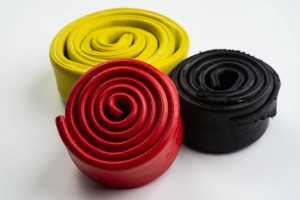Apple Rubber offers a variety of standard compounds suitable for most of our customer’s needs, but sometimes something special is needed. Below are some specific compounds we developed for our customers over the years.
Why Standards Matter
Polymer chemists strive to formulate compounds that meet multiple specifications within a single compound. Utilizing multi-purpose compounds minimizes the necessity for numerous formulations and reduces raw material inventory.
Examples include:
- NBR compound meeting ASTM D2000 BG specifications and Mil-G-21569 or Mil-R-6855 standards
- FKM compound meeting ASTM D2000 HK specifications and AMS 3216 or MIL-R-83248 standards
- Silicone compound meeting ASTM D2000 GE specifications and AMS 3304 or A-A-59588 Class 2 standards
Standard compounds are often more cost-effective, as molders procure them in larger quantities and maintain ample safety stock.
Custom Colored Oil Gasket NBR Compound
An Apple Rubber customer required a composite seal matching the color of their logo, opting for a yellow NBR compound. The project aimed for an excellent operating temperature range, low swell in engine oil, and some weathering resistance. Adjusting the NBR compound’s acrylonitrile percentage to 33% achieved the desired temperature range and reduced oil swell. Transitioning from a black to colored compound involved replacing carbon black with white fillers, necessitating adjustments due to reduced reinforcement. Antioxidants and antiozonants were incorporated for heat and weathering resistance without causing staining. The white base compound was sent to the color supplier for Pantone color matching. Following development, the compound underwent ASTM D2000 compliance checks and trial runs in production tools to ensure compatibility and bonding with steel inserts.
Propane Valve Seal
Many seals produced are used in propane industry valves or measuring equipment. A customer noted shrinkage in seals after prolonged exposure to air during propane service. Propane acted as a solvent, extracting oil from the NBR compound formulation. While in propane service, sufficient compound swell occurred for normal valve operation. However, drying out led to seal shrinkage, causing leaks upon reuse. Standard compound extraction tests were conducted, exploring different plasticizers. Testing involved volume swell after immersion and subsequent dry-out periods, aiming for compliance with UL-157 propane service testing using n-hexane. The goal was to prevent excessive swelling that would fail UL requirements while avoiding shrinkage leading to valve leaks. Once the suitable oil was identified, compatibility with molding tools was ensured, and UL approval was sought.
Other Considerations
Each rubber compound comprises essential components: polymer, filler, processing aid, protectant, and cure. Considerations extend beyond functionality to encompass sustainable sourcing, environmental regulations, and future restrictions. Compliance with regulations such as ROHS, REACH, Prop 65, EU MDR, and FDA 21 CFR 177.2600 is paramount.
Note: Apple Rubber provides finished parts rather than formulation recommendations. For formulation inquiries, contact your polymer supplier or raw material distributor.
